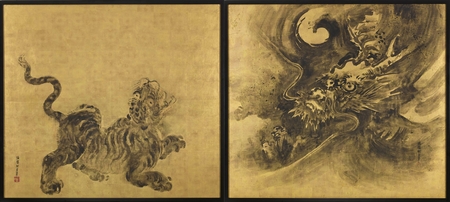Product Description
7200/1 A pair of paper panels painted in ink on a gold ground depicting a dragon and a tiger
Signed: Hōgen Tansaku hitsu (Painted by Tansaku with the title of Hōgen)
Seal: (unidentified)
Japan 18th century Edo period
Dimensions: H. 54¼” x W. 60½” (137.5cm x 153.5cm) each
n.b. These panels were originally mounted as a Tsuitate (standing screen) and have recently been remounted as individual panels.
Tsurusawa Tansaku (ca. 1729-1797)
Given name: Tsuruzawa Moriteru, Gō (art name): Tansaku
Tansaku was the son of the court painter Tsuruzawa Tangei (1688-1769) and painted in a traditional Kanō style. He was one of Maruyama Ōkyo’s first teachers and later in his career received the title of *hōgen, the second highest honorary title bestowed upon artists.
In the traditional cosmology of China the tiger is one of the Four Sacred Creatures, it represents autumn, the west, the wind and the colour white. It is thus the compliment of the dragon, which represents the east, the spring and water. The interaction of the two, the play of wind and water – is thought vital for creating weather that makes soil fertile and crops prosper.
Works by the artist can be found in the collection of: The Fine Arts Museum, Boston; Indianapolis Museum of Art, Indianapolis.
For a six-fold screen by Tsurusawa Tansaku showing a dragon amongst clouds see Indianapolis Museum of Art, acquisition number 79.350 and for a pair of screens with the same subject matter painted by Kanō Tan’yu see: Nihon Byōbu-e Shūsei, vol.16: Soju ga (Wild Animals)- Dragons, Tigers and Monkeys, p.34-35, pl.22 & 23.











